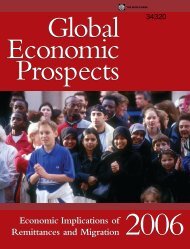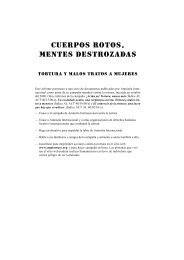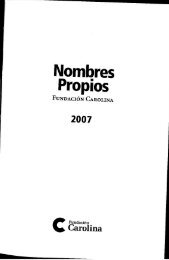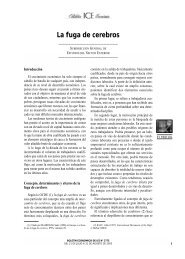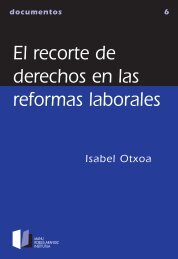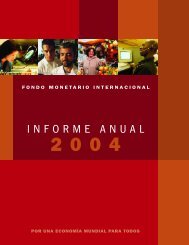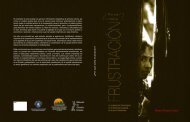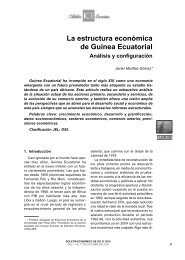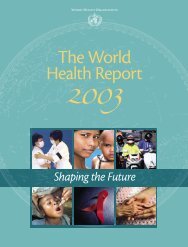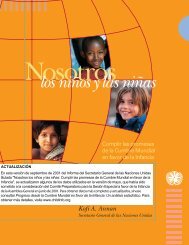Educación para todos: el imperativo de la calidad; Informe ... - eFaber
Educación para todos: el imperativo de la calidad; Informe ... - eFaber
Educación para todos: el imperativo de la calidad; Informe ... - eFaber
- No tags were found...
Create successful ePaper yourself
Turn your PDF publications into a flip-book with our unique Google optimized e-Paper software.
005436 / ANEXO2<strong>Informe</strong> <strong>de</strong> Seguimiento <strong>de</strong> <strong>la</strong> Educación <strong>para</strong> Todos en <strong>el</strong> MundoCamboya. 1999. Education in Cambodia. Phnom Penh, Ministerio <strong>de</strong> Educación, Juventud y Deporte,Departamento <strong>de</strong> <strong>la</strong> P<strong>la</strong>nificación.Card, D. 1999. “The causal effect of education on earnings” en O. C. Ashenf<strong>el</strong>ler y D. Card (compi<strong>la</strong>dor),Handbook of <strong>la</strong>bor economics. Amsterdam, Elsevier, Vol. 3A, Capítulo 30.Carnegie Corporation of New York. 1994. Starting points: meeting the needs of our youngest children.Nueva York, The Carnegie Corporation of New York.Carneiro, P.; y Heckman, J. J. 2003. Human capital policy. Cambridge (Massachusetts, EE.UU.), Oficina Nacional<strong>de</strong> Investigación Económica (Documento <strong>de</strong> trabajo <strong>de</strong> <strong>la</strong> NBER Nº 9.495, febrero).Carnoy, M. 2004. Education for all and the quality of education: a reanalysis. Documento <strong>de</strong> referencia <strong>para</strong><strong>el</strong> <strong>Informe</strong> <strong>de</strong> Seguimiento <strong>de</strong> <strong>la</strong> EPT en <strong>el</strong> Mundo 2005.Carnoy, M.; Gove, A; y Marshall, J. H. 2003. Why do stu<strong>de</strong>nts achieve more in some countries than in others?A com<strong>para</strong>tive study of Brazil, Chile, and Cuba. Stanford, Universidad <strong>de</strong> Stanford, Escu<strong>el</strong>a <strong>de</strong> Educación.Carr-Hill, R. A. 2004a. HIV/AIDS, poverty and educational statistics in Africa: evi<strong>de</strong>nce and indicators.Montreal, Instituto <strong>de</strong> Estadística <strong>de</strong> <strong>la</strong> UNESCO (IEU).Carr-Hill, R. A. 2004b. Additional material on literacy rates. Documento <strong>de</strong> referencia <strong>para</strong> <strong>el</strong> <strong>Informe</strong> <strong>de</strong>Seguimiento <strong>de</strong> <strong>la</strong> EPT en <strong>el</strong> Mundo 2005.Carr-Hill, R. A.; Kweka, A. N.; Rusimbi, M.; y Cheng<strong>el</strong><strong>el</strong>e, R. 1991. The functioning and effects of the Tanzanianliteracy programme. París, Instituto Internacional <strong>de</strong> P<strong>la</strong>neamiento <strong>de</strong> <strong>la</strong> Educación (IIPE) <strong>de</strong> <strong>la</strong> UNESCO(<strong>Informe</strong> <strong>de</strong> investigación IIPE Nº 93).Carroll, J. B. 1963. “A mod<strong>el</strong> of school learning”. Teachers College Record, Vol. 64, págs. 722-733.—. 1989. “The Carroll mod<strong>el</strong>, a 25-year retrospective and prospective view”. Educational Researcher,Vol. 18, págs. 6-31.Carron, G.; Mwiria, K.; y Righa, G. 1989. The functioning and effects of the Kenya literacy programme. París, InstitutoInternacional <strong>de</strong> P<strong>la</strong>neamiento <strong>de</strong> <strong>la</strong> Educación (IIPE) <strong>de</strong> <strong>la</strong> UNESCO (<strong>Informe</strong> <strong>de</strong> investigación IIPE Nº 76).Casassus, J.; Cusato, S.; Froem<strong>el</strong>, J. E.; y Pa<strong>la</strong>fox, J. C. 2002. Primer estudio internacional com<strong>para</strong>tivo sobr<strong>el</strong>enguaje, matemática y factores asociados en tercero y cuarto grado. Segundo <strong>Informe</strong>. Santiago,OREALC/UNESCO.Case, A.; y Deaton, A. 1999. “School inputs and educational outcomes in South Africa”. Quarterly Journalof Economics, Vol. 114, Nº 3, págs. 1.047-1.084.Case, A.; y Yogo, M. 1999. Does school quality matter? Returns to education and the characteristics of schoolsin South Africa. Cambridge (Massachusetts, EE.UU.), Oficina Nacional <strong>de</strong> Investigación Económica(Documento <strong>de</strong> trabajo <strong>de</strong> <strong>la</strong> NBER Nº 7.399).Cawthera, A. 2003. Nijera shikhi & adult literacy (www.<strong>el</strong>dis.org/fulltext/nijerashikhi.pdf).Centro <strong>de</strong> Exc<strong>el</strong>encia <strong>para</strong> <strong>el</strong> Desarrollo <strong>de</strong> <strong>la</strong> Primera Infancia. 2004. Encyclopedia on early childhood <strong>de</strong>v<strong>el</strong>opment.Montreal (www.exc<strong>el</strong>lence-earlychildhood.ca).Centro Estadístico Nacional <strong>de</strong> <strong>la</strong> República Democrática Popu<strong>la</strong>r Lao. 1997. Lao census 1995: country report.Vientiane, Comité Nacional <strong>de</strong> P<strong>la</strong>nificación.Centro Europeo <strong>de</strong> Fundaciones. 2002. In<strong>de</strong>pen<strong>de</strong>nt funding: a directory of foundation and corporate membersof the European Foundation Centre. Brus<strong>el</strong>as, Centro Europeo <strong>de</strong> Fundaciones.CERI. 1999. Education policy analysis. París, Centro <strong>para</strong> <strong>la</strong> Investigación e Innovación Educativas (CERI), OCDE.—. 2002. Educational research and <strong>de</strong>v<strong>el</strong>opment in Eng<strong>la</strong>nd: examiners’ report. París, París, Centro <strong>para</strong> <strong>la</strong>Investigación e Innovación Educativas (CERI), OCDE.Chabbott, C. 2004. UNICEF’s child-friendly schools’ framework. A <strong>de</strong>sk review. <strong>Informe</strong> <strong>para</strong> <strong>el</strong> UNICEF.Chandra, R. 2004. Discurso pronunciado con motivo <strong>de</strong> <strong>la</strong> inauguración d<strong>el</strong> Proyecto PRIDE. Suva (Fiji),Universidad d<strong>el</strong> Pacífico Sur, 14 <strong>de</strong> mayo.Chazée, L. 1999. The peoples of Laos: rural and ethnic diversities. Bangkok, White Lotus.Ch<strong>el</strong>u, F.; y Mbulwe, F. 1994. “The s<strong>el</strong>f-h<strong>el</strong>p action p<strong>la</strong>n for primary education (SHAPE) in Zambia” en A. Little,W. Hoppers y R. Gardner (compi<strong>la</strong>dores), Beyond Jomtien: implementing primary education for all.Londres, Macmil<strong>la</strong>n, págs. 99-123.Chisholm, L. 2004. The quality of primary education in South Africa. Documento <strong>de</strong> referencia <strong>para</strong> <strong>el</strong> <strong>Informe</strong><strong>de</strong> Seguimiento <strong>de</strong> <strong>la</strong> EPT en <strong>el</strong> Mundo 2005.Chiswick, B.; Patrinos, H.; y Tamyo, S. 1996. The economics of <strong>la</strong>nguage: application to education.Washington, D. C., Banco Mundial.





